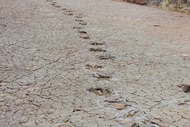Create a free profile to get unlimited access to exclusive videos, sweepstakes, and more!
Incredible time-lapse video: Monsoon IV

I get a lot of emails. But when I get one from someone like Mike Olbinski, I open it immediately. Why? Because Olbinski, a wedding photographer by profession, is also a storm chaser, and when he sends me a note I know I’m about to watch another jaw-dropper of a time-lapse video. And the subject line of this email — “Monsoon IV” — made me click the link pretty dang fast.
When you watch it I’m pretty sure you’ll agree, because holy wow. Make sure you have it set to the highest resolution you can handle, make it full screen, and turn the volume up.
See? I told you.
Olbinski shot this over five weeks, driving nearly 21,000 kilometers across Arizona, California, and New Mexico. It was a huge effort, and the outcome is just magnificent.
Before I point out some of the things to note in the video, let me give some praise to the music composer, Peter Nanasi. He worked with Olbinski as the video was created, which is why the musical cues are right on the money in timing and drama. This video would be spectacular without a soundtrack, but with it … well. It heightens the tension and releases it beautifully. I listened to some more of his music as I wrote this article, and it’s quite lovely.
My favorite bits of the video:
Right after the title comes up, you can see some dust devils playing over the desert. These look similar to tornadoes, but form in a different way and are much weaker. They’re also seen quite often on Mars!
The appearance of a fleeting double rainbow at 2:10 was pretty surprising. That sort of organized colorful beauty amid the chaos is striking.
The colors of the setting Sun accentuate the rotation of the storm system over traffic in a particularly arresting scene at about 3:40. I like how the exposure times get longer to compensate for the falling light (note how the streaks from car headlights get longer), which only adds to the drama.
At 5:25 the Milky Way makes an appearance. I’m always drawn to the contrast between stormy and cloudy skies when it comes to these types of systems; I grew up on the East Coast where it’s usually cloudy for a while before a storm, so seeing stars at the same time as rain is a bit off-kilter to me. Now that I live in Colorado it’s a much more familiar sight!
I think my favorite part starts at 6:02, when a supercell forms and a huge surge of colder air drops down from it. This picks up dust from the ground and blasts outward in a circular wave. Watching it approach is like something out of a big-budget sci-fi movie. The orange/tan color of the dust contrasts strongly with some of the other bits of footage showing intense and deep blue hues to the clouds; that cerulean glow is likely due to the presence of hail held aloft by convecting winds inside the cloud. But that’s not entirely certain.
Watching this, I get a chill thinking of the energies involved. The mass of water in a storm cloud can be millions of kilograms, and the force of convection keeps it roiling and swirling. Moving around masses like that takes phenomenal energy, more than a nuclear weapon! Think of the damage a big storm can do, and perhaps that statistic isn’t as surprising as it might be initially.
I’m lucky to be able to watch storms here in Colorado, too, and sometimes see some truly remarkable phenomena. I hope I never lose my love for the beauty and science of such things. And if you want to indulge your own, try watching Olbinski’s other videos like Monsoon I, Monsoon II, or Monsoon III (and you’ll find out why, as I mentioned earlier, I clicked on his link so quickly when I found out this was the fourth in the series). I also recommend his videos Vorticity, Pulse, and a short shot of some amazing undulatas asperatus, because trust me, that last one is unearthly.
As long as he keeps making videos like these, I’ll be happy to consume them. It gives me a deeper appreciation for living on the seabed of the ocean of air above us.


























